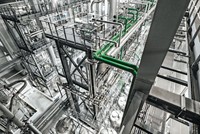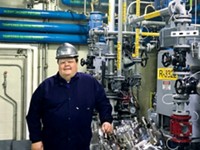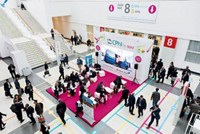Advertisement
Grab your lab coat. Let's get started
Welcome!
Welcome!
Create an account below to get 6 C&EN articles per month, receive newsletters and more - all free.
It seems this is your first time logging in online. Please enter the following information to continue.
As an ACS member you automatically get access to this site. All we need is few more details to create your reading experience.
Not you? Sign in with a different account.
Not you? Sign in with a different account.
ERROR 1
ERROR 1
ERROR 2
ERROR 2
ERROR 2
ERROR 2
ERROR 2
Password and Confirm password must match.
If you have an ACS member number, please enter it here so we can link this account to your membership. (optional)
ERROR 2
ACS values your privacy. By submitting your information, you are gaining access to C&EN and subscribing to our weekly newsletter. We use the information you provide to make your reading experience better, and we will never sell your data to third party members.
Outsourcing
Siegfried marks its 150th anniversary with a foray into cell and gene therapy
Swiss pharmaceutical services firm crafts a global one-stop shop rooted in tradition
by Rick Mullin
June 4, 2023
| A version of this story appeared in
Volume 101, Issue 18

The Swiss pharmaceutical services firm Siegfried recently announced the acquisition of DiNAMIQS, a maker of viral vectors for cell and gene therapy, and it plans to build a commercial-scale manufacturing facility at DiNAMIQS’s site in Schlieren, Switzerland, scheduled to open in 2025.
Siegfried at a glance
▸ Headquarters: Zofingen, Switzerland
▸ Sales: $1.3 billion (drug substance, 61%; drug product, 39%)
▸ Net profit: $141 million
▸ Employees: ~3,600
▸ Sites: Total of 11 in China, France, Germany, Malta, Spain, Switzerland, and the US
Source: Company. Note: Figures are for 2022.
Siegfried’s “mid double-digit million Swiss Francs” purchase of 95% of DiNAMIQS, as the deal is described in a press release, is modest compared with acquisitions in cell and gene therapy by larger services firms, such as Thermo Fisher Scientific and WuXi AppTec. But the biologics function adds a fundamentally new facet to Siegfried, which has grown rapidly over the past 15 years in its effort to provide drug industry customers with services for both active pharmaceutical ingredients (APIs), known as drug substance, and finished drugs, known as drug product.
The deal also suggests a continuing transformation at the once-family-owned company, which announced the deal on the eve of its 150th anniversary celebration at its headquarters in Zofingen, Switzerland. It’s a transformation that has accelerated in recent years with global expansion and the addition of services such as sterile fill and finish of liquid drug product.
An earlier transformation began in 1973, when Siegfried made a public offering of stock on the Swiss Stock Exchange. The move coincided with the firm’s 100th anniversary. In the years that followed, the firm shifted from producing its own drugs to manufacturing drug substance and drug product as a service for other companies.
With a string of acquisitions in Europe and the US and a $60 million investment in a plant in Chinacomparable in scale to its headquarters plant in Zofingen, Siegfried has colored outside the lines of its traditional roots. But the roots are healthy, says Wolfgang Wienand, the firm’s CEO.
“In our business, you don’t grow by adding financial assets but by doing more,” says Wienand, who took the helm at Siegfried in 2019. “More capacity, more people, more chemicals, and more pills—by growing the company at that pace and still being able to create a corporate culture.” A culture, he says, defined by a well-established, unifying quality system.
Wienand, formerly a research director at the German chemical company Evonik Industries, arrived at Siegfried as chief scientific officer in 2010. At the time, Siegfried had annual sales of about $314 million and 700 people at three sites, in Switzerland, the US, and Malta. “Look at the company now,” he says: “1.2 billion Swiss francs revenue, 3,600 people working at 11 sites.”
Much of the growth stems from a program implemented by his predecessor, Rudolf Hanko, a former Bayer and Degussa executive, who took the corner office in 2009. Siegfried, like most firms, had been heavily impacted by the 2008 recession and was responding with process optimization and streamlining. Hanko shifted to a strategy of integrating its businesses in drug substance and drug product, which had operated separately.
To carry out the integration at its plants in Malta and Zofingen, the firm set up a centralized analytic laboratory at the Swiss site. In 2012, it acquired Alliance Medical Products in Irvine, California, establishing a new service in sterile fill and finish. The following year, Siegfried began construction of a plant in Nantong, China.
Next came expansion in Europe with the acquisition of Hameln Pharma, a German specialist in sterile filling, in 2014 and API facilities in Germany, Switzerland, and France from BASF in 2015. Most recently, Siegfried acquired two Novartis manufacturing sites near Barcelona, Spain—an ophthalmic sterile drug plant and a solid-dose form site—in 2020.
“It’s a really different company,” Wienand says. “We made use of what we are—a drug substance and drug product company. Based on these capabilities and a certain idea about how the future supply models in the industry probably would look, we developed this idea of an integrated offering.”

Wienand acknowledges that there are still questions about drug industry customers’ demand for such an integration of services, as well as disagreement about the practicality of operating two different businesses—one manufacturing chemicals and the other making pills and sterile liquid drugs. But he sees Siegfried’s strategy as a risk that paid off, given the increased interest among drugmakers for consolidating contractors.
In the pharmaceutical services business, Siegfried was early to embrace drug product and early to expand internationally. Wienand notes that the China and California investments were preceded by a 1927 joint venture with Ganes Chemical in Pennsville, New Jersey, and a partnership with a Taiwanese company in the 1980s. Siegfried eventually acquired Ganes.
The China project, Wienand says, was a controlled risk. “We took a long-term perspective,” he says, “driven by the question of ‘Where is the significant part of mankind?’ ” The other question had to do with how to integrate operations in China with those in Europe and the US.
Wienand describes a two-phase program: the manufacture of intermediates for conversion into APIs in Switzerland and the production of APIs for the world market, including supply to the rising cohort of innovative Chinese drug companies. “I would dare say we are at the inflection point where the second phase is about to start,” he says.

Meanwhile, the DiNAMIQS acquisition opens a door for growth, according to Wienand. “We took a dozen high-end, cutting-edge scientists and fully fledged laboratories and pilot facilities, and we will build that out with our own funds to a commercial-scale cell and gene therapy manufacturing platform,” he says. “This acquisition is a very important one for Siegfried, and I think in hindsight it will be viewed as comparable in importance to the other seemingly more significant acquisitions that we did in the past.”
Marianne Späne, Siegfried’s chief business officer and a 20-year veteran of the firm, says the DiNAMIQS deal reflects a conservative investment approach in keeping with a business culture stemming from Siegfried’s family-owned roots. “It’s amazing that still, with the growth, we have kept the Siegfried family approach,” she says. “It means you are really belonging to Siegfried. If you ask the Novartis people [that joined the company with the Spanish acquisition], they feel integrated; they feel appreciated as a new member.”
Späne was elevated to the firm’s executive committee in 2008, becoming one of very few women in executive positions in an industry that even today is heavily dominated by men. Irene Wosgien joined the executive committee as chief operating officer for drug substance in 2021.
Growth at Siegfried is bringing more change to the executive committee—many members have been with the firm for 3 years or less. And the committee is expanding. Siegfried announcedearlier this year that Christian Dowdeswell, head of commercial development for small molecules at the competitor Lonza, is coming in as chief business officer for drug substance in June; Späne will continue to serve as chief business officer for drug product.
The new blood in the executive lineup is a response to the overall growth of the company, Wienand says. “The kind of company we are running today is not the company of 5 or 10 years ago, and that impacts the management style.”
Stock analysts see Siegfried as in a good position going forward. A March report published by Baader Helvea Equity Research was headlined, “Keep the Faith! Story Fully on Track” and says a double-digit drop in Siegfried’s share price in 2022 after an all-time high the previous year was “an overreaction.”
In its positive outlook, Baader says assets at the acquired Novartis sites will be better utilized going forward because of the addition of non-Novartis contracts. The stock research firm also believes growth across Siegfried’s businesses is compensating for the drop in revenue after the expiration last year of a 2020 contract to provide aseptic filling for BioNTech’s COVID-19 vaccine.
Other industry watchers also see Siegfried managing growth effectively. James Bruno, president of the consulting firm Chemical and Pharmaceutical Solutions, says the evolution of management at Siegfried has supported the addition of new business lines. The culture has evolved as well. “To me they seem to be less concerned about the past and more about the future,” says Bruno, who started in the industry working for Ganes in the 1970s.
Another analyst, Roger Laforce, sees the company lining up with some of the largest pharmaceutical services firms. “Siegfried obviously wants to become a kind of service company that can handle any technology. A one-stop shop,” he says. The company has successfully added technology expertise through acquisition, adopting the approach of broad services firms such as CordenPharma, Lonza, Thermo Fisher, and SK Pharmteco, Laforce says.
Wienand says Siegfried’s guiding principle continues to be a forward perspective on market needs. “We still believe, and this is the word we get from the market, in the years to come, the more complexity you take over for the customers, the more you help your customers focus on their true value driver, which is innovation, marketing, and distribution,” he says.
The company continues to invest, breaking ground earlier this year on a $27 million R&D center in Evionnaz, Switzerland.
And at 150, Siegfried remains poised for acquisition, Wienand says. “We have something like a half-billion Swiss francs to invest in acquisitions,” he says. Prospects include expansions in areas where the company is already active. “The BASF deal, for example. If something like that comes around the corner, we would do it again for sure.”





Join the conversation
Contact the reporter
Submit a Letter to the Editor for publication
Engage with us on Twitter